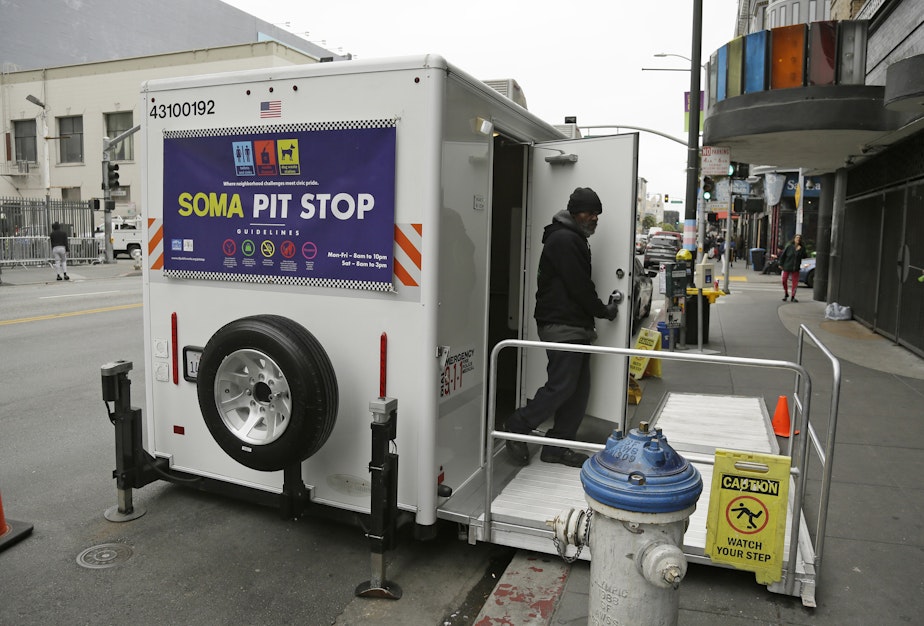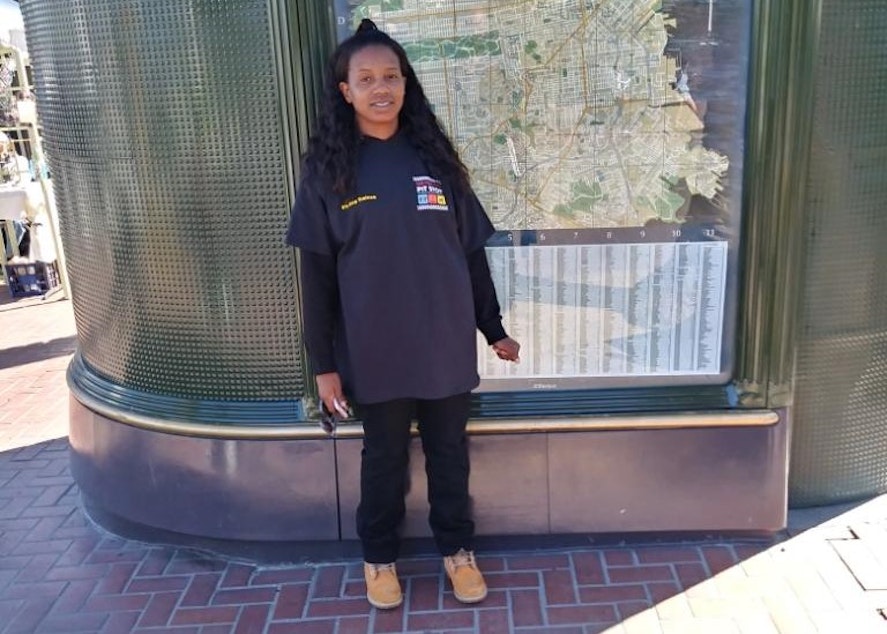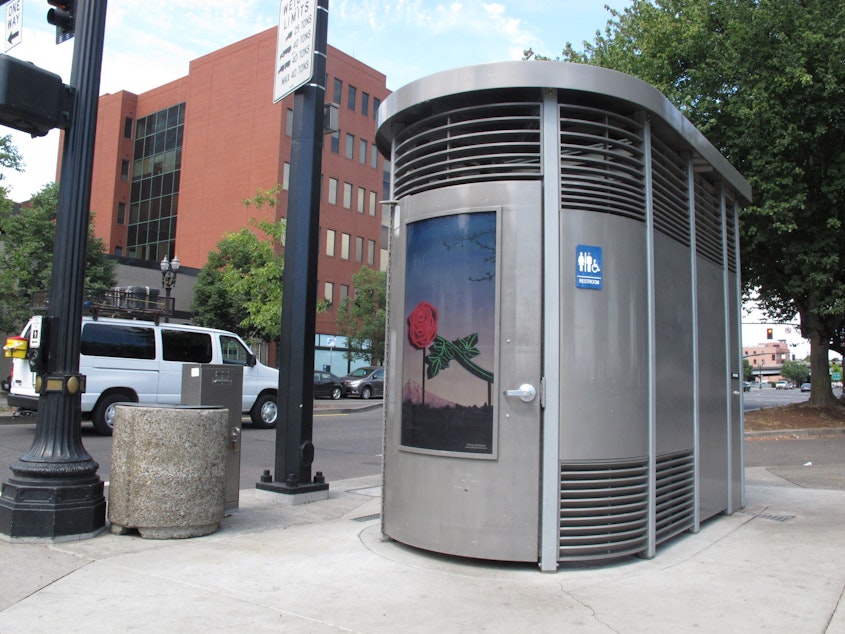'A toilet is your face.' Seattle ponders the perfect public pissoir

Has any city figured out public toilets? We investigate.
Deep below the sidewalk in Pioneer Square is a beautiful public restroom, with 25 stalls built from brass and white Alaskan marble.
Need a shoe shine? It’s got six stations for that too ... if only you could penetrate the concrete and get down there.
This restroom closed during World War II, never to reopen. Not that people have stopped peeing there.
On a recent visit I saw two fresh splatters of urine on the wrought iron pergola columns above ground. Like homing pigeons pulled north, the pee migrated down toward the interred urinals.
This "comfort station" of days gone by is part of Seattle’s unfortunate past of public toilet fails, including five ill-fated bathrooms costing $1 million each that the city installed in 2004 and quickly ripped out.
Sponsored
Now, Seattle has over a hundred publicly funded toilets at city parks and libraries . Only six are open after hours, according to a recent report by the Seattle city auditor.
“We just don't have enough public toilets that are available to individuals,” said Tiffani McCoy, Real Change lead organizer. “Unless you are able to go into a cafe and buy a coffee or something to eat, or if you ‘look acceptable,’ which often has a very racist overtone.”
Real Change’s recent campaign, “Everybody Poos,” is trying to increase the number of toilets for everyone, whether you’re homeless or not.
McCoy and others in Seattle believe San Francisco has an answer.
Sponsored
Known as “Pit Stops,” San Francisco has 25 locations around the city with free public toilets staffed by an attendant, or pit stop monitor. The Pit Stops see a flow of people from different backgrounds throughout the day, Pit Stop monitor and supervisor Neima Hawkins said in an interview over the phone from San Francisco.
“Morning time is really like the homeless people. But in the afternoons a lot of city workers use it,” she said. “People who are on their lunch break. Nighttime is more like everybody: children, older people, homeless people, people shopping, tourists.”

Other cities consider the model to be so successful that they are adopting it, too, including Los Angeles, Miami, and Denver.
Sponsored
San Francisco’s toilets weren’t always so reputable. Before the Pit Stop monitors were employed, people moved into the toilets.
“I've seen people be in there for days with their shopping carts and blankets and just like needles everywhere,” said Neima Hawkins, the Pit Stop monitor and a life-long San Francisco resident.
Now every bathroom has a five-minute limit.
“We're like banging on the door, like, ‘You have another minute left. Bam bam bam. Your time is up.’ If they're like, ‘My stomach hurts. Can you give me a few more minutes?’ Then we're good," she said. "But sometimes they're like, “Oh, screw you!” and ‘I'm not coming out!’”
In that case, the person inside gets a warning, and then the monitor can unlock the door and open it from the outside to force that person to leave, Hawkins said. Sometimes the monitors will call the police to evict someone from a bathroom.
Sponsored
The monitors are also there to clean the bathrooms, and make sure they’re a good space for everyone. All Pit Stops have sharps containers and doggy bags for people to pick up poop on the go. Hawkins noticed that sometimes people asked her for doggy bags, even though she couldn’t see a pet by their side.
It turns out the people wanted the bags for their own poop, instead of having to leave it on the ground.
“That's sad but it's true,” she said. Handing them a bag, Hawkins said she thanked them for cleaning up behind themselves.
In San Francisco, the program has expanded from permanent structures that look like roundish green pods. It now also includes mobile toilets.
Two toilets come on the back of a trailer, trucked in and out of a location every day. They have air-conditioning, electricity, and running water to power a flush toilet, unlike a Port-a-Potty.
Sponsored
San Francisco still has a problem with feces on the sidewalk in places, but Hawkins said she noticed the areas around the toilets are cleaner because of her and her team’s work, she said.
“It's kind of a thankless job, but at the end of the day you know you made a difference in that area,” she said.
Perhaps paradoxically, public toilets can’t have too much privacy to be effective.
In 2004, Seattle installed five high-tech toilets from Germany with the promise that the facilities would clean themselves. They didn’t work, though, and visitors to the toilets used them as places to use drugs and sell sex instead. After spending $5 million to put them in, the city ripped them out again.
Not only did the design insulate toilet users too much from the outside, they felt “prison-like,” said public toilet advocate, Carol McCreary of the organization, Public Hygiene Lets Us Stay Human (PHLUSH).
The “Portland Loo” installed in Ballard over the summer avoids that problem by connecting the inside toilet to the outside street environment through angled, open slats, at the bottom of the toilet allowing passersby to see the floor of the Loo.
“If someone has fallen to the ground, they can be seen and help can be called,” McCreary said. “The Loo relies on the natural monitoring of the community.”
Eyes on the toilet work to keep it safe, she said, and can take the form of cleaning teams, adjacent cart-based vendors, or, as the San Francisco model shows, attendants.
The next question is whether Seattle will fund them.
It cost $550,000 to install the Ballard Commons’ Portland Loo — a single loo.
By contrast, the annual cost for five mobile Pit Stops, a total of 10 toilets, is roughly $726,000, said Real Change’s McCoy. The City Council will include a funding request in Seattle’s budget for next year.

“What's great about (mobile Pit Stops) is you don't have to build out that brick and mortar structure you don't have to worry about plumbing, or electricity and retrofitting,” she said.
Seattle City Council member Lisa Herbold has requested $1.3 million in start-up costs and $726,000 for on-going operations in next year's budget to create staffed mobile restrooms that include facilities to dispose of needles and pet waste.
Jack Sim, the founder of the Singapore-based WTO – the World Toilet Organization – said he’s happy to consult with Seattle city council members to help the city work through our public toilet problems.
I called him up for a global perspective. Sim mentioned one country that’s particularly good at public toilets: Japan.
“In Japan all public toilets are clean. So you can actually feel very confident going into any one of them.”
And Japanese public toilets are plentiful, thoroughly sprinkled throughout the country train stations, department stores, and playgrounds.
Sim credits Japanese culture for this success.
In Japan, the toilet represents your outward-facing identity, what you do and what you stand for, Sim said.
“A toilet is your face.”

